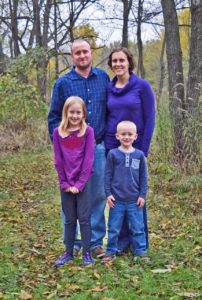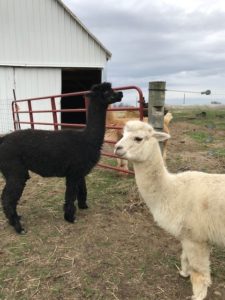A Thoughtful Approach to Engineering and Life
How Krista Gearhart cultivates ideas and puts them to action in her role at ASG and at home on her alpaca farm
Krista Gearhart is a successful, published engineer and patent owner. Born and raised in Southern Indiana, she graduated with a B.S. in Biomedical Engineering, Biomaterials from Rose-Hulman Institute of Technology and a M.S. in Biomedical Engineering, Orthopedic Biomaterials from IUPUI. She began her career at Cook Medical and then moved to Caterpillar for five years. Krista has worked as a biomedical engineer and technical writer at ASG for a little over five years.

Krista has great insights on working in the medical industry. Read this Q&A to learn what she thinks about being a biomedical engineer and how she uses her background in her current role to keep ASG clients happy. Krista, who lives on a farm in West Lafayette, Ind., with her family, also has some great advice on becoming a biomedical engineer … and on balancing alpaca farming and family life with a career in engineering.
You have two patents. Tell us about them.
Those are from the first company I worked for, Cook Medical, where I worked on permanently implantable devices. The patents are in the area of controlling drug evolution from a device. We were trying to incorporate a drug and figure out the best way for that drug to be released, as well as the most effective timeline.
To draft the patents, I had to learn how to describe a process with technical elements in enough detail so that my idea was significantly different than others. I had to choose the right language and descriptions in order to make the device patentable, which helps me in my technical writing today.
What’s your role at ASG?
I provide engineering supports wherever needed. Lately, I’ve been doing mostly risk management support. There’s a lot of documentation needed to show that we’ve looked at the risk of the device design, the device manufacturing process and how the user uses the device to make it as safe as possible. I write protocols and reports drafting factory acceptance testing (FAT) of devices and manufacturing equipment.
How do you solve a problem?
When working on a risk management project, there’s a team that needs to go through their manufacturing process for packaging and a process failure, mode, effects and analysis (PFEMA). I go through their manufacturing process step by step. I brainstorm ways that the process can fail, and failure modes that may result in damage to the device or harm the patient. Then, I have to think about the causes of the failure modes, and what controls are in place to prevent the failure modes from happening. We try to rank the probability of the failure recurring and the harm to the patient.
What inspires you?
Knowing my work is needed and that it helps advance a project is motivating. I’ve been in places in the past where I kind of felt like: Is this really ever going to go anywhere? Will this be needed at some point? At ASG, I know the work we’re doing contributes to an FDA submission for a device or helps get something approved and on the market.
Also, the people here are reasonable and flexible. Being in a smaller company helps with that. We avoid some of the politics you get at bigger companies. I remember when I first started, I was overwhelmed with a 6-month-old and 3-year-old. The people at ASG appreciated the work I did, and they worked with my schedule and trained me fairly quickly. So, it was a pretty smooth process. Some of the other team members were really awesome in helping me get established. I’m glad I stuck it out.
Any advice for others who may be interested in this field of work?
If you want to work in an industry like medical devices or pharmaceuticals, it can feel like a marathon. Sometimes it can take years before a project is actually in the hands of a patient. So, it’s important to take a step back and look at the progress because it seems really slow at times. It’s just the way it is in a heavily regulated environment.
Also, I think a lot of people think biomedical engineers work in a lab all day. There’s definitely some time spent working in a lab, but the job is really 80-90% paperwork. There’s so much documentation required. And rightly so. If you’re going to implant something into someone’s body, then you’d better make sure it’s right.
How do you balance your work and home life?

What works for me might not work for everyone. When my kids were little and I had to miss work, I felt so much guilt. Now that I look back, I think that wasn’t a big deal. I still got my work done. I work part-time and that helps me manage my work with our family and farm. I know that not everybody has that luxury.
My kids are 6 and 8 now. We are big into gardening. We grow tomatoes, eggplant, green beans, lettuce, kale and other fruits and vegetables. We have some fruit trees. It makes summer busy, but I enjoy it. It kind of forces me to eat more vegetables.
We also have eight alpacas. I guess I’m an alpaca shepherd. We get them sheared every year, and I’m big into knitting and crocheting. I use their yarn to make socks and other things, which make great Christmas gifts for friends and family. I think it’s good for our kids to help with the animals.
Does Krista’s job sound interesting to you? Learn more about careers at ASG.





